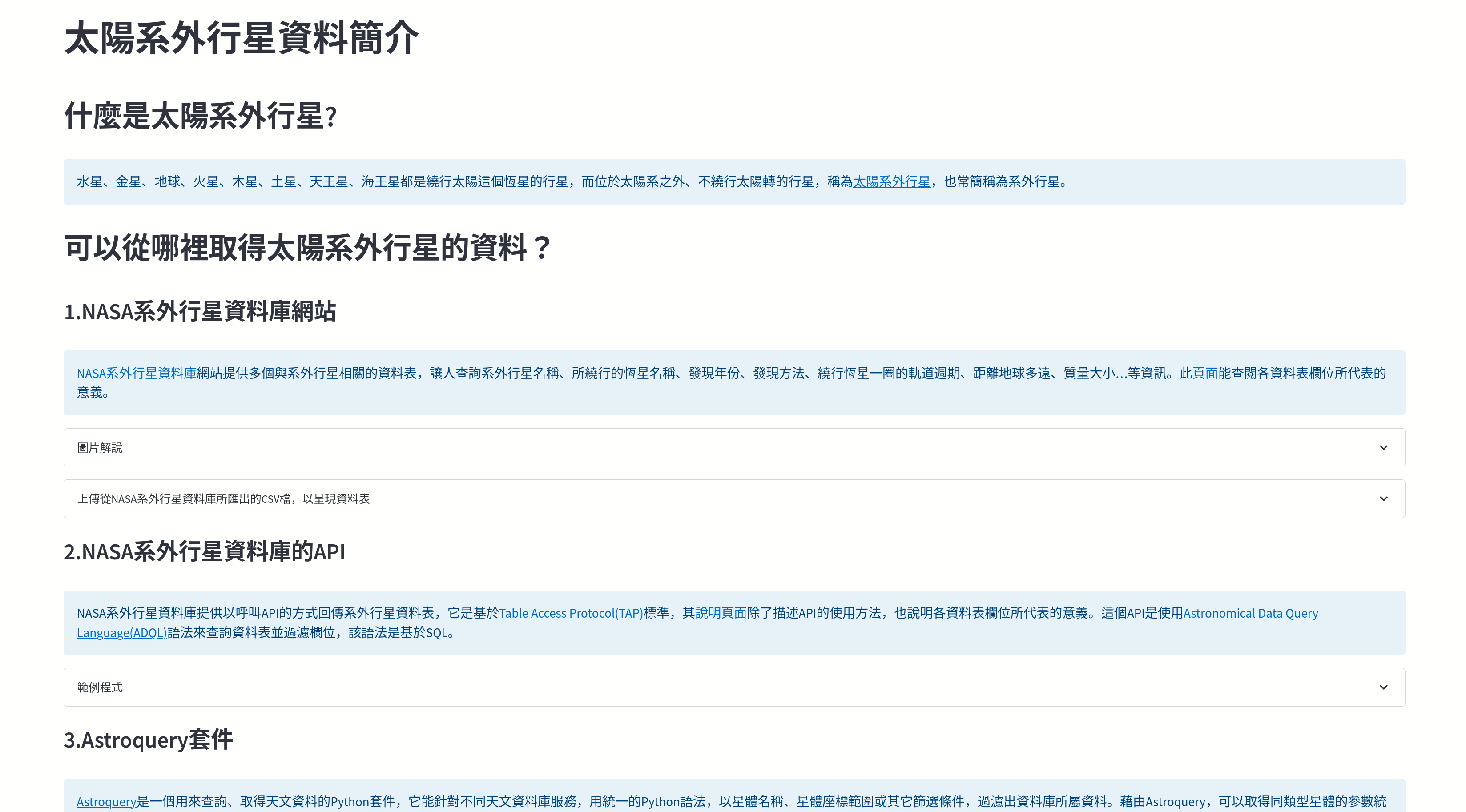「跟著黑蛋用Streamlit速成天文資料分析Web App」系列文[6]:再版系外行星資料簡介app,添加範例程式於頁面上
September 21st, 2022
經過這幾天的研究,黑蛋了解到,除了可以透過NASA系外行星資料庫網站手動下載系外行星資料表外,也可以藉由API或Astroquery套件取得,因此,他想將後兩者方法的介紹及使用範例,也加入到之前用Streamlit製作的系外行星資料簡介app中。
首先,黑蛋把這兩個方法的標題及簡介加到exoplanet_data_intro.py這個Python script中:
# exoplanet_data_intro.py
import streamlit as st
st.header('可以從哪裡取得太陽系外行星的資料?')
# 中略
st.subheader('2.NASA系外行星資料庫的API')
st.info('NASA系外行星資料庫提供以呼叫API的方式回傳系外行星資料表,它是基於[Table Access Protocol(TAP)](https://www.ivoa.net/documents/TAP/)標準,其[說明頁面](https://exoplanetarchive.ipac.caltech.edu/docs/TAP/usingTAP.html)除了描述API的使用方法,也說明各資料表欄位所代表的意義。這個API是使用[Astronomical Data Query Language(ADQL)](https://www.ivoa.net/documents/ADQL/20180112/PR-ADQL-2.1-20180112.html)語法來查詢資料表並過濾欄位,該語法是基於SQL。')
st.subheader('3.Astroquery套件')
st.info('[Astroquery](https://astroquery.readthedocs.io/)是一個用來查詢、取得天文資料的Python套件,它能針對不同天文資料庫服務,用統一的Python語法,以星體名稱、星體座標範圍或其它篩選條件,過濾出資料庫所屬資料。藉由Astroquery,可以取得同類型星體的參數統整資料表(例如:系外行星資料表),或是特定星體在不同電磁波段的影像、光譜、時序等觀測資料。')
接著,他想藉由Streamlit呈現程式碼,他查到有兩種方法:st.code和st.echo,前者是以較方便的方式呈現Markdown的程式區塊,後者則可以將Python script中某段可執行的程式直接顯示在app頁面上。黑蛋決定先用st.code來呈現較精簡的範例,然後用st.echo來包裝較完整、可執行的函式,如此一來,他可以在Python script中藉由按鈕元件st.button,讓使用者在頁面上點擊按鈕後呼叫該函式並呈現系外行星資料表。
# exoplanet_data_intro.py中的Astroquery使用範例
import streamlit as st
from astroquery.ipac.nexsci.nasa_exoplanet_archive import NasaExoplanetArchive
astroquery_example_code = '''
from astroquery.nasa_exoplanet_archive import NasaExoplanetArchive
# 在query_criteria()中指定要取得哪個系外行星資料表的哪些欄位
table_name = 'pscomppars'
columns = 'pl_name,hostname,sy_dist,pl_orbper,pl_bmasse,pl_rade,disc_year,discoverymethod'
exoplanet_table = NasaExoplanetArchive.query_criteria(table=table_name, select=columns)
'''
with st.expander('範例程式'):
st.code(astroquery_example_code, language='python')
with st.echo():
def get_exoplanet_table_by_astroquery():
table_name = 'pscomppars'
columns = 'pl_name,hostname,sy_dist,pl_orbper,pl_bmasse,pl_rade,disc_year,discoverymethod'
exoplanet_table = NasaExoplanetArchive.query_criteria(
table=table_name, select=columns
)
exoplanet_table = exoplanet_table.to_pandas()
exoplanet_table = exoplanet_table.rename(
columns={
'pl_name': '行星名稱',
'hostname': '所屬恆星名稱',
'sy_dist': '與地球的距離(單位:秒差距)',
'pl_orbper': '行星軌道週期(單位:天)',
'pl_bmasse': '行星質量(單位:地球質量)',
'pl_rade': '行星半徑(單位:地球半徑)',
'disc_year': '發現年份',
'discoverymethod': '發現方法'
}
)
exoplanet_table.sort_values(
by='發現年份', ascending=False, inplace=True, ignore_index=True
)
return exoplanet_table
if st.button('執行get_exoplanet_table_by_astroquery()並呈現系外行星資料表'):
exoplanet_table = get_exoplanet_table_by_astroquery()
st.dataframe(exoplanet_table)
最後,他再版了系外行星資料簡介app,頁面展示及完整程式碼如下:

# exoplanet_data_intro.py
import pandas as pd
import streamlit as st
from astroquery.ipac.nexsci.nasa_exoplanet_archive import NasaExoplanetArchive
page_title = '太陽系外行星資料簡介'
st.set_page_config(page_title=page_title, page_icon=':star', layout='wide')
st.title(page_title)
st.header('什麼是太陽系外行星?')
st.info('水星、金星、地球、火星、木星、土星、天王星、海王星都是繞行太陽這個恆星的行星,而位於太陽系之外、不繞行太陽轉的行星,稱為[太陽系外行星](https://zh.wikipedia.org/zh-tw/%E5%A4%AA%E9%99%BD%E7%B3%BB%E5%A4%96%E8%A1%8C%E6%98%9F),也常簡稱為系外行星。')
st.header('可以從哪裡取得太陽系外行星的資料?')
st.subheader('1.NASA系外行星資料庫網站')
st.info('[NASA系外行星資料庫](https://exoplanetarchive.ipac.caltech.edu/)網站提供多個與系外行星相關的資料表,讓人查詢系外行星名稱、所繞行的恆星名稱、發現年份、發現方法、繞行恆星一圈的軌道週期、距離地球多遠、質量大小…等資訊。此[頁面](https://exoplanetarchive.ipac.caltech.edu/docs/TAP/usingTAP.html)能查閱各資料表欄位所代表的意義。')
with st.expander('圖片解說'):
st.image(
'https://media.heptabase.com/v1/images/e336080b-183d-4940-892f-a27e91a48b9b/d1a626a7-f228-41aa-9a87-767301f596b0/NASAExoplanetArchive.png',
caption='NASA系外行星資料庫網站首頁。點擊左上角的「Confirmed Planets」可以查看「Planetary Systems」資料表,而「Planetary Systems Composite Data」資料表可從右下角進入。'
)
st.image(
'https://media.heptabase.com/v1/images/e336080b-183d-4940-892f-a27e91a48b9b/8da2f51f-ddae-4b0a-845f-b3d667fc9e3f/ConfirmedPlanetsTable.png',
caption='「Planetary Systems」資料表,不同研究團隊針對同一個行星所作的研究結果會在這張表分別列出。'
)
st.image(
'https://media.heptabase.com/v1/images/e336080b-183d-4940-892f-a27e91a48b9b/51772e03-2a3e-48bb-9a40-0cc24a00bf21/PlanetarySystemsCompositeDataTable.png',
caption='「Planetary Systems Composite Data」資料表,能一行綜觀同個行星的所有欄位值。點擊左上方的「Download Table」可將資料表以CSV格式匯出。'
)
with st.expander('上傳從NASA系外行星資料庫所匯出的CSV檔,以呈現資料表'):
uploaded_csv = st.file_uploader('選擇要上傳的CSV檔')
if uploaded_csv is not None:
exoplanet_table = pd.read_csv(uploaded_csv)
st.text('系外行星資料表')
st.dataframe(exoplanet_table)
st.subheader('2.NASA系外行星資料庫的API')
st.info('NASA系外行星資料庫提供以呼叫API的方式回傳系外行星資料表,它是基於[Table Access Protocol(TAP)](https://www.ivoa.net/documents/TAP/)標準,其[說明頁面](https://exoplanetarchive.ipac.caltech.edu/docs/TAP/usingTAP.html)除了描述API的使用方法,也說明各資料表欄位所代表的意義。這個API是使用[Astronomical Data Query Language(ADQL)](https://www.ivoa.net/documents/ADQL/20180112/PR-ADQL-2.1-20180112.html)語法來查詢資料表並過濾欄位,該語法是基於SQL。')
api_example_code = '''
import pandas as pd
# 在API網址中用ADQL的select...from...語法,查詢能一行綜觀同個行星所有欄位值的資料表「Planetary Systems Composite Parameters」,並篩選所需欄位。
table_name = 'pscomppars'
columns = 'pl_name,hostname,sy_dist,pl_orbper,pl_bmasse,pl_rade,disc_year,discoverymethod'
nasa_exoplanet_archive_api = f'https://exoplanetarchive.ipac.caltech.edu/TAP/sync?query=select+{columns}+from+{table_name}&format=csv'
exoplanet_table = pd.read_csv(nasa_exoplanet_archive_api)
'''
with st.expander('範例程式'):
st.code(api_example_code, language='python')
with st.echo():
def get_exoplanet_table_by_nasa_api():
table_name = 'pscomppars'
columns = 'pl_name,hostname,sy_dist,pl_orbper,pl_bmasse,pl_rade,disc_year,discoverymethod'
nasa_exoplanet_archive_api = 'https://exoplanetarchive.ipac.caltech.edu/TAP/sync?query='
nasa_exoplanet_archive_api += f'select+{columns}+from+{table_name}&format=csv'
exoplanet_table = pd.read_csv(nasa_exoplanet_archive_api)
exoplanet_table = exoplanet_table.rename(
columns={
'pl_name': '行星名稱',
'hostname': '所屬恆星名稱',
'sy_dist': '與地球的距離(單位:秒差距)',
'pl_orbper': '行星軌道週期(單位:天)',
'pl_bmasse': '行星質量(單位:地球質量)',
'pl_rade': '行星半徑(單位:地球半徑)',
'disc_year': '發現年份',
'discoverymethod': '發現方法'
}
)
exoplanet_table.sort_values(
by='發現年份', ascending=False, inplace=True, ignore_index=True
)
return exoplanet_table
if st.button('執行get_exoplanet_table_by_nasa_api()並呈現系外行星資料表'):
exoplanet_table = get_exoplanet_table_by_nasa_api()
st.dataframe(exoplanet_table)
st.subheader('3.Astroquery套件')
st.info('[Astroquery](https://astroquery.readthedocs.io/)是一個用來查詢、取得天文資料的Python套件,它能針對不同天文資料庫服務,用統一的Python語法,以星體名稱、星體座標範圍或其它篩選條件,過濾出資料庫所屬資料。藉由Astroquery,可以取得同類型星體的參數統整資料表(例如:系外行星資料表),或是特定星體在不同電磁波段的影像、光譜、時序等觀測資料。')
astroquery_example_code = '''
from astroquery.nasa_exoplanet_archive import NasaExoplanetArchive
# 在query_criteria()中指定要取得哪個系外行星資料表的哪些欄位
table_name = 'pscomppars'
columns = 'pl_name,hostname,sy_dist,pl_orbper,pl_bmasse,pl_rade,disc_year,discoverymethod'
exoplanet_table = NasaExoplanetArchive.query_criteria(table=table_name, select=columns)
'''
with st.expander('範例程式'):
st.code(astroquery_example_code, language='python')
with st.echo():
def get_exoplanet_table_by_astroquery():
table_name = 'pscomppars'
columns = 'pl_name,hostname,sy_dist,pl_orbper,pl_bmasse,pl_rade,disc_year,discoverymethod'
exoplanet_table = NasaExoplanetArchive.query_criteria(
table=table_name, select=columns
)
exoplanet_table = exoplanet_table.to_pandas()
exoplanet_table = exoplanet_table.rename(
columns={
'pl_name': '行星名稱',
'hostname': '所屬恆星名稱',
'sy_dist': '與地球的距離(單位:秒差距)',
'pl_orbper': '行星軌道週期(單位:天)',
'pl_bmasse': '行星質量(單位:地球質量)',
'pl_rade': '行星半徑(單位:地球半徑)',
'disc_year': '發現年份',
'discoverymethod': '發現方法'
}
)
exoplanet_table.sort_values(
by='發現年份', ascending=False, inplace=True, ignore_index=True
)
return exoplanet_table
if st.button('執行get_exoplanet_table_by_astroquery()並呈現系外行星資料表'):
exoplanet_table = get_exoplanet_table_by_astroquery()
st.dataframe(exoplanet_table)
此系列文由蘇羿豪撰寫,以「創用CC 姓名標示 4.0(CC BY 4.0)國際版授權條款」釋出。
Subscribe to 天文背包黑客
Receive the latest updates directly to your inbox.
Mint this entry as an NFT to add it to your collection.
Verification
This entry has been permanently stored onchain and signed by its creator.
Arweave Transaction
evUgCDPt6uzk5qk…HZGwJnZGihdDifE
Author Address
0xCc6C492e6F4947f…A5d20ffE942d7c3
Content Digest
_KbEVxA-482kI3I…eXaJzMUAVaCp-7Q